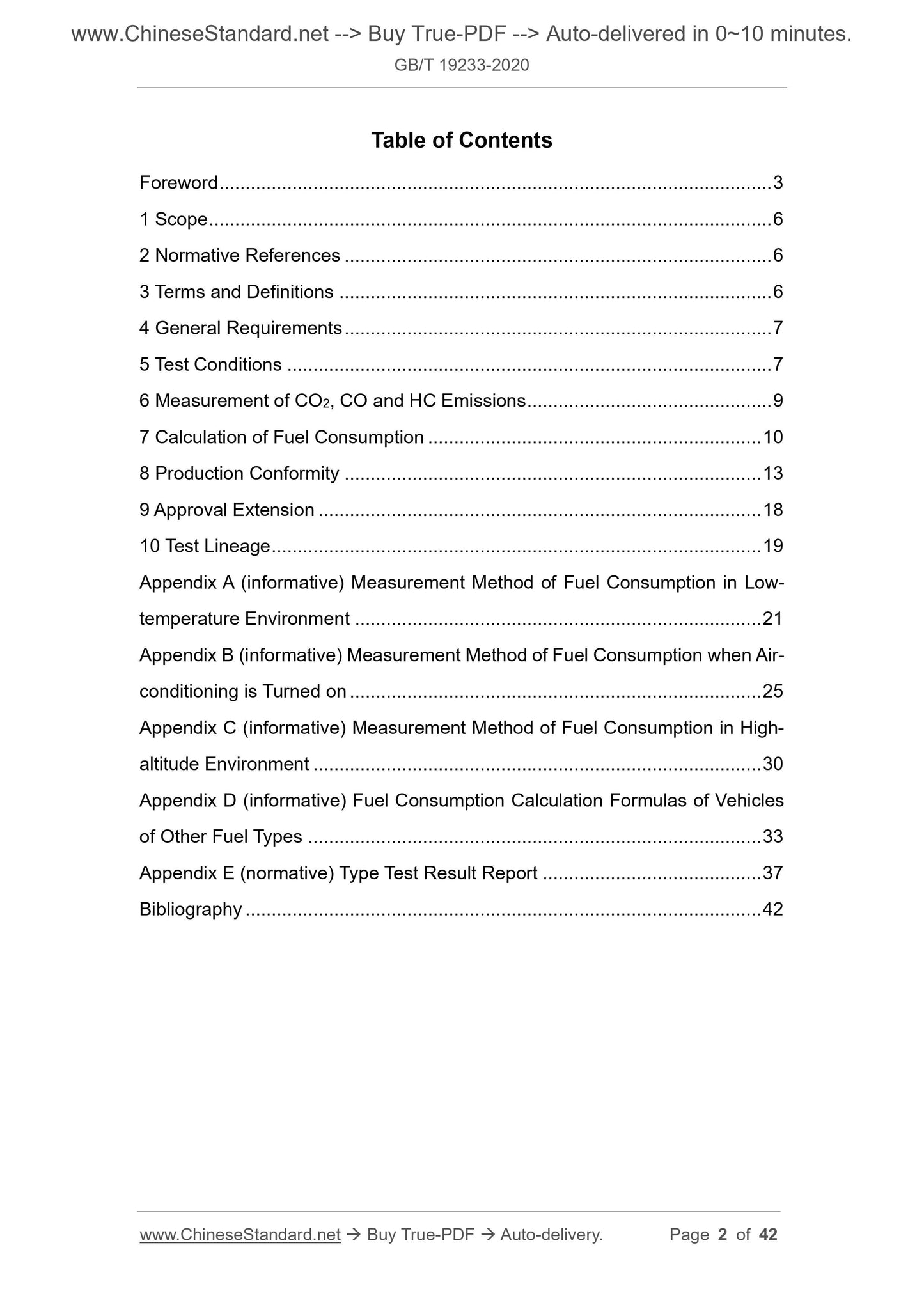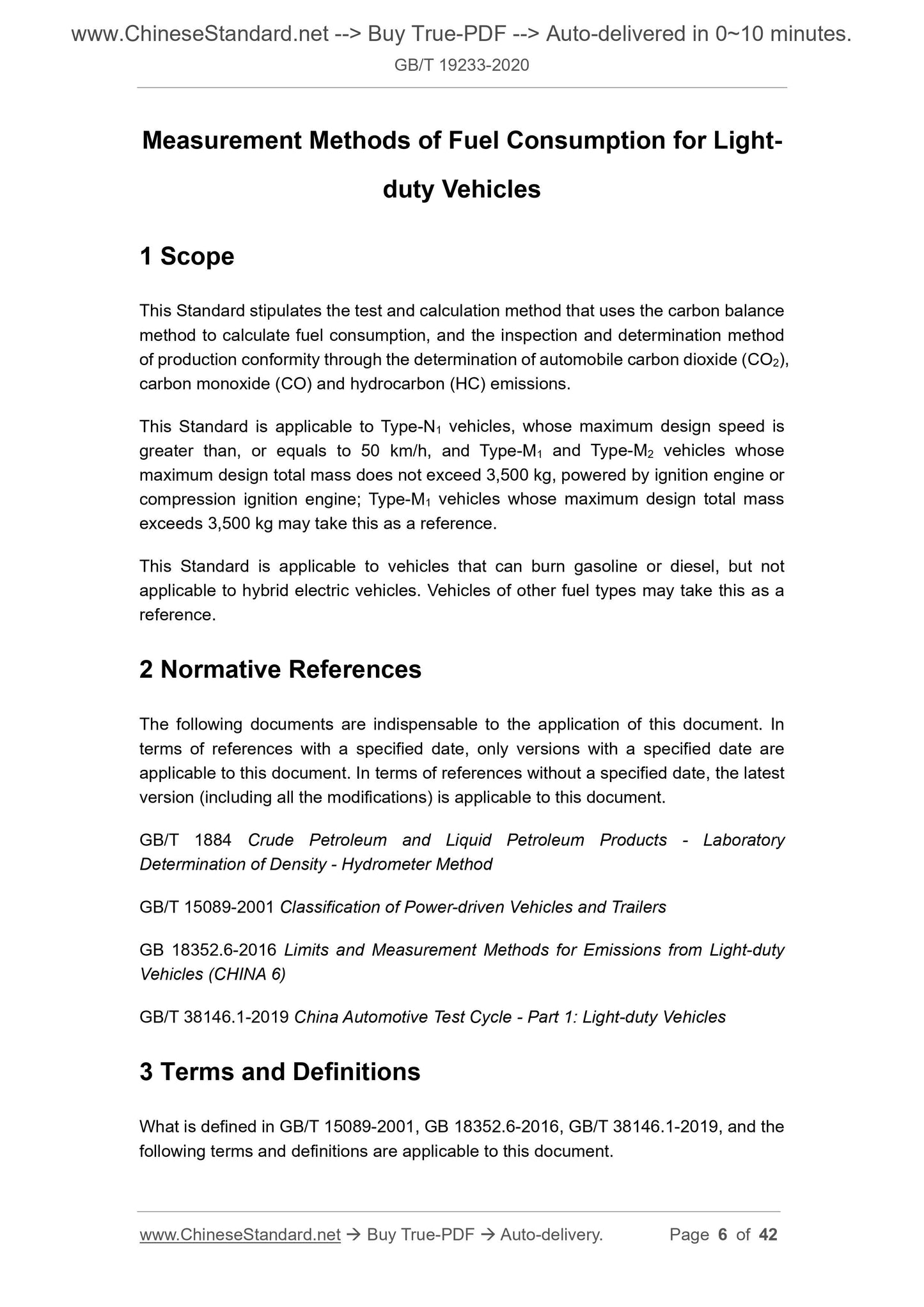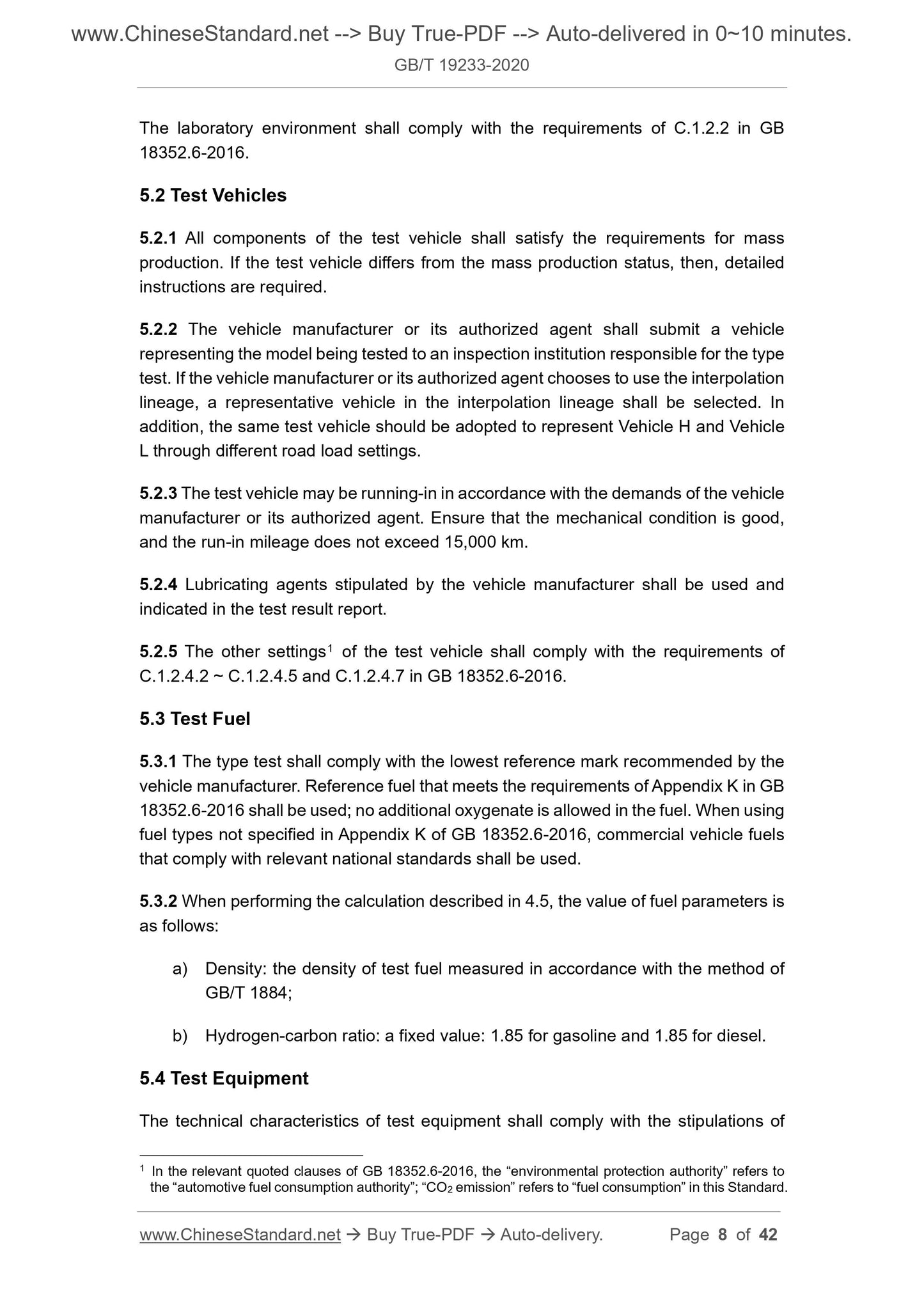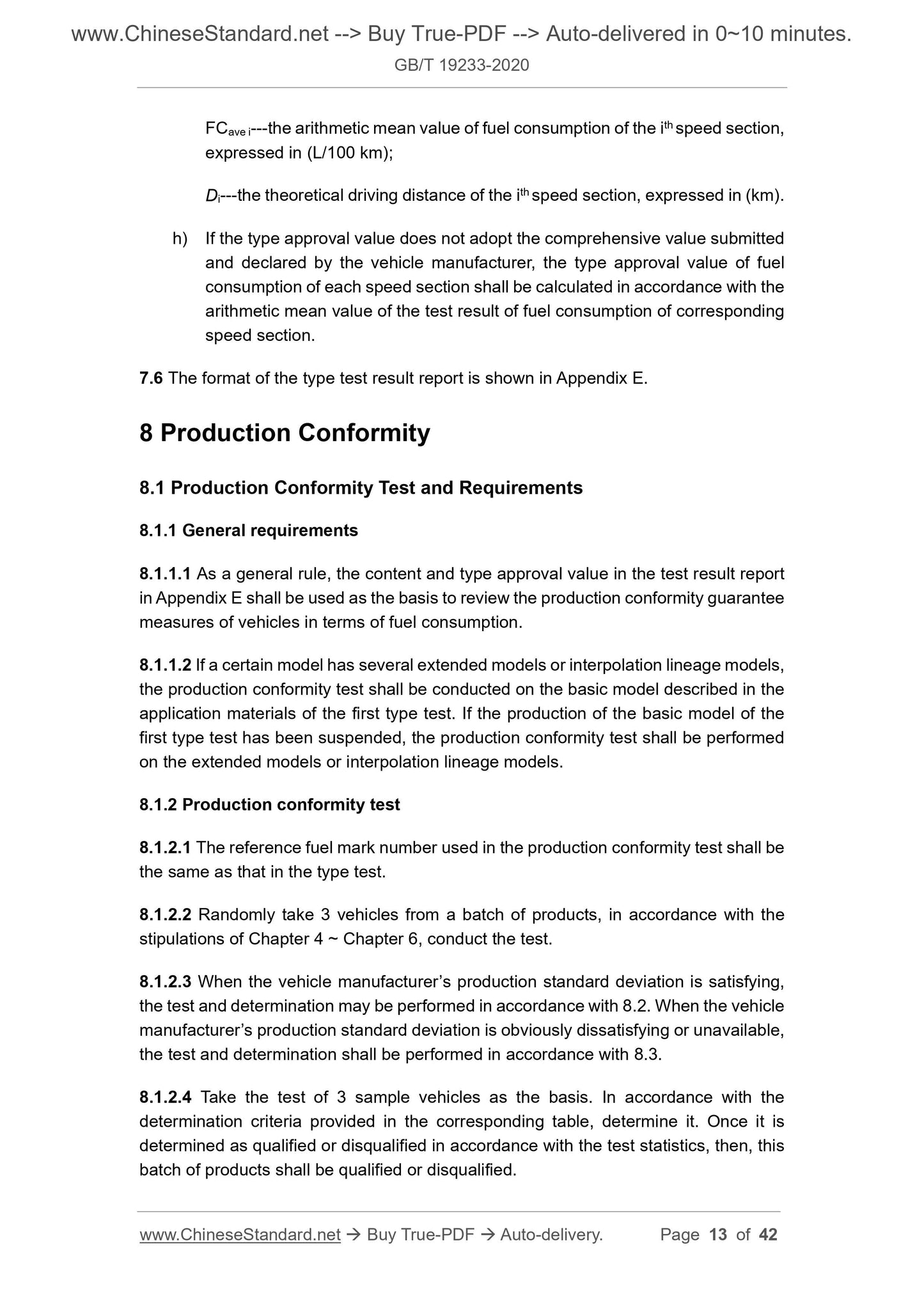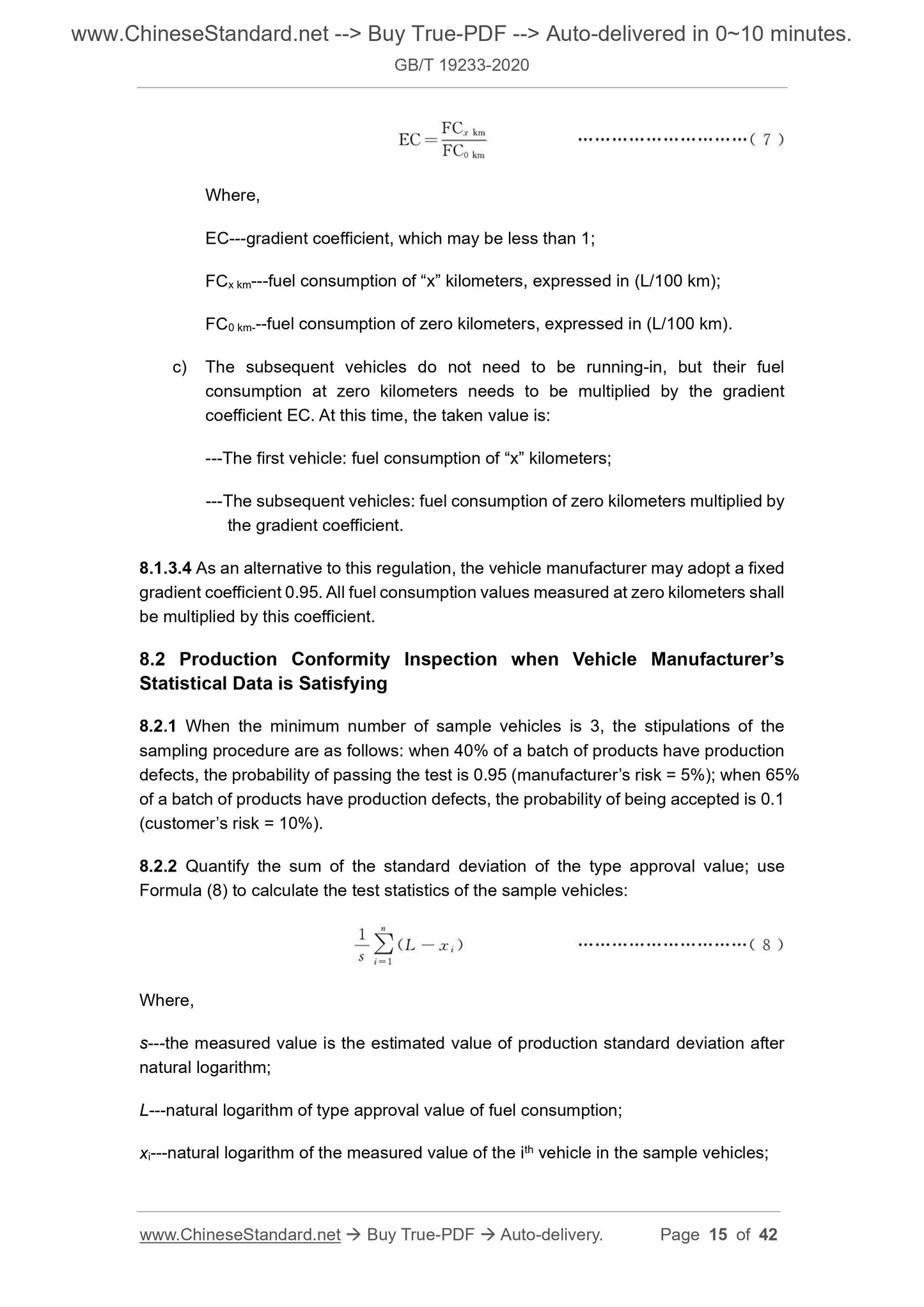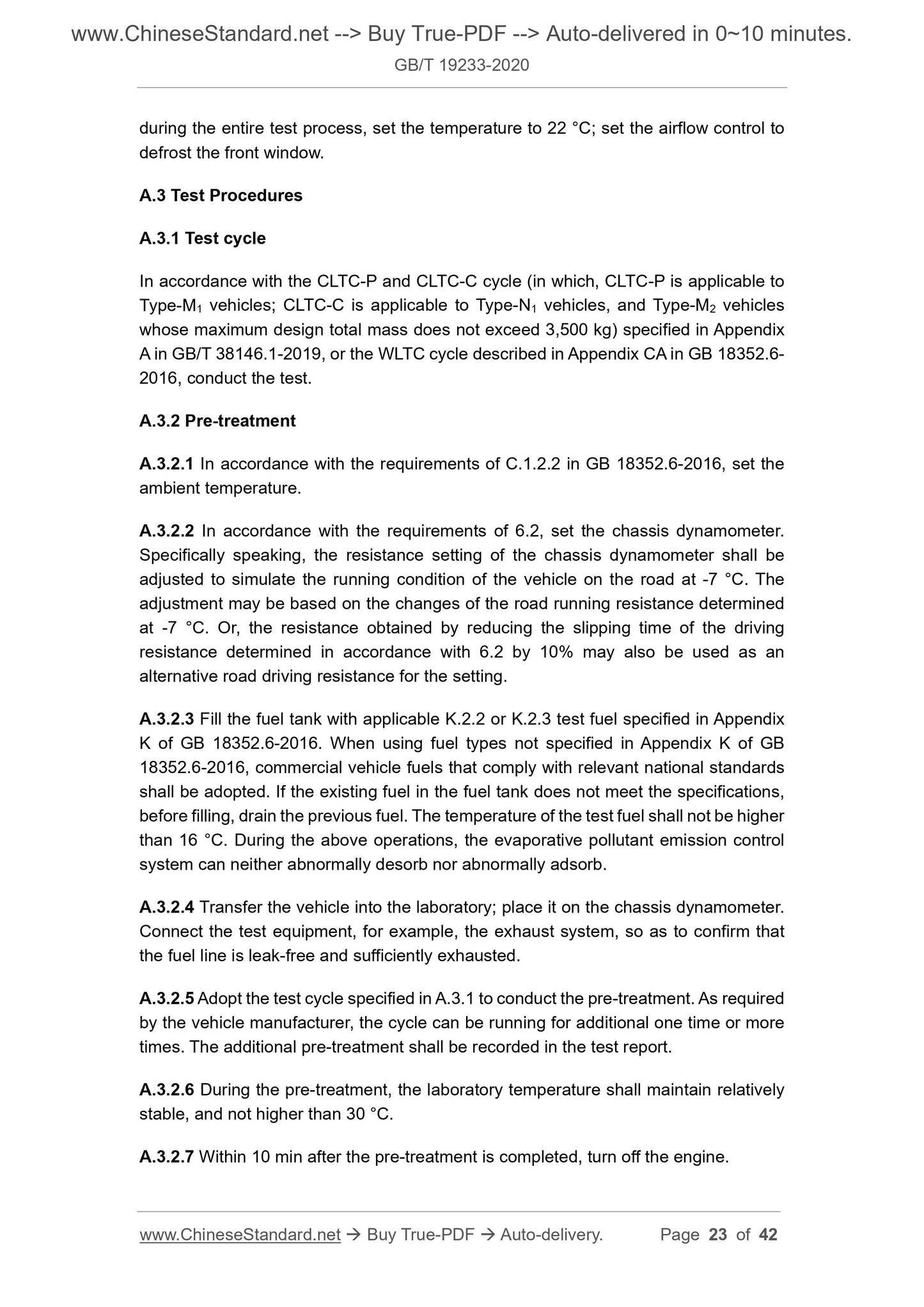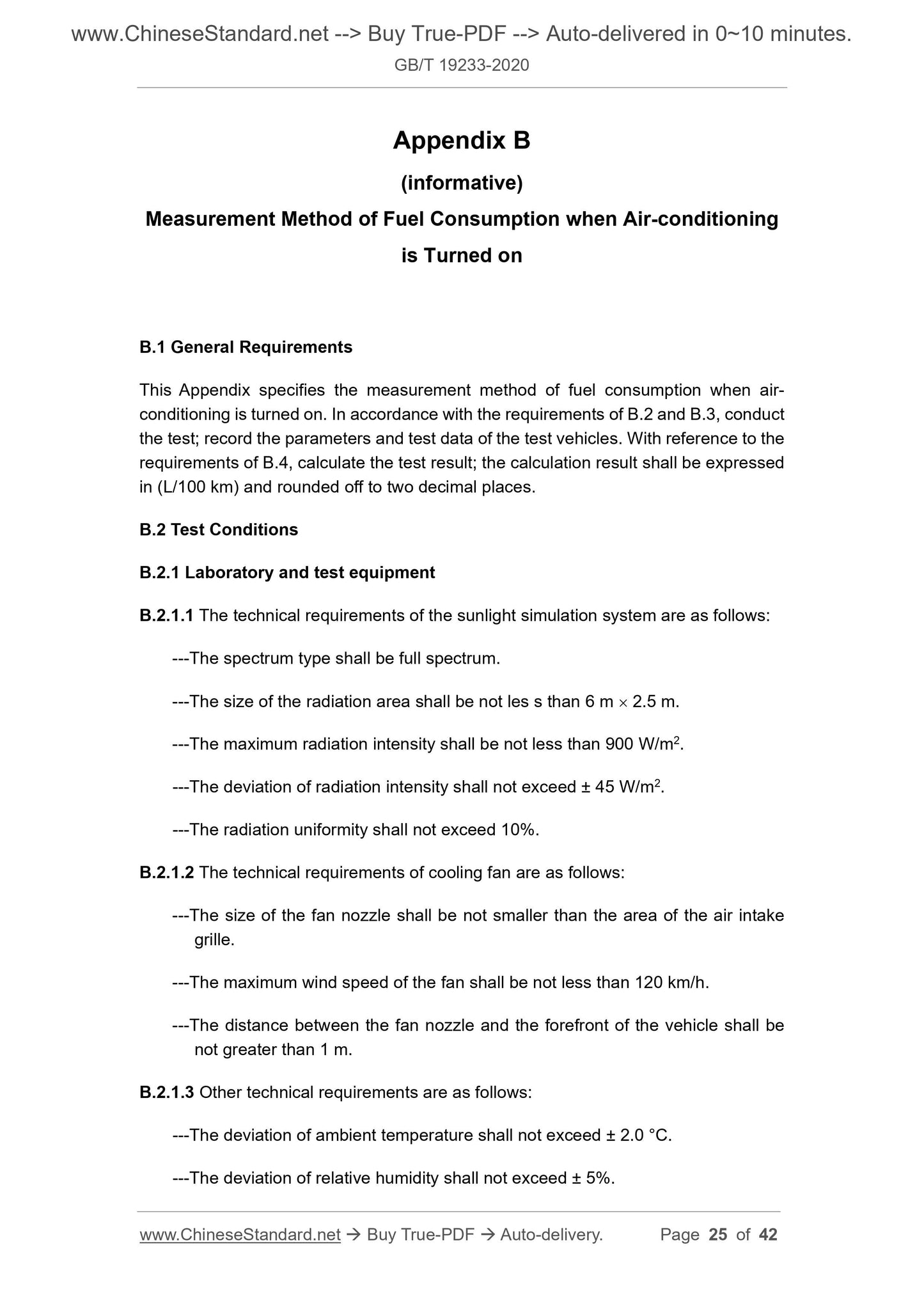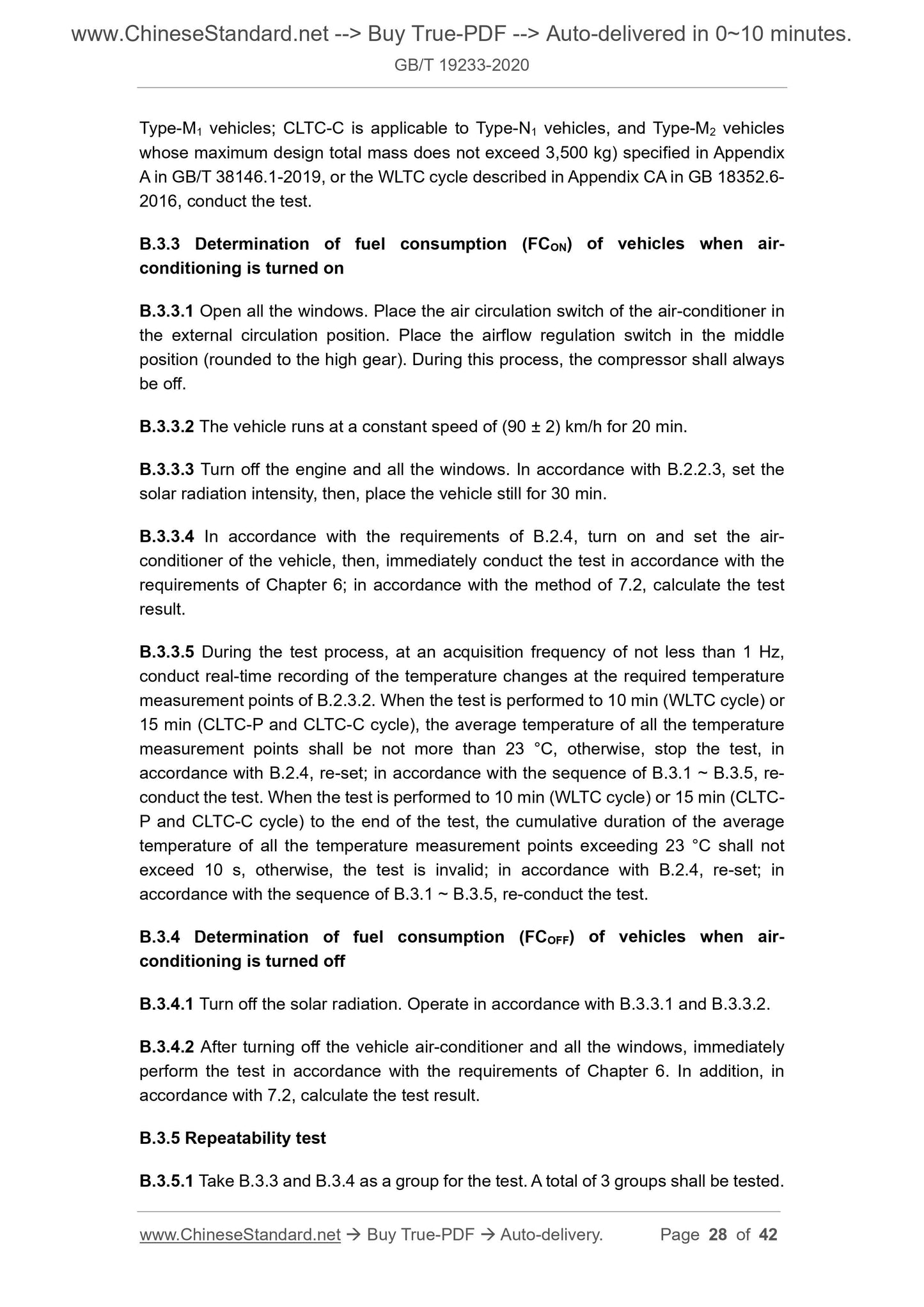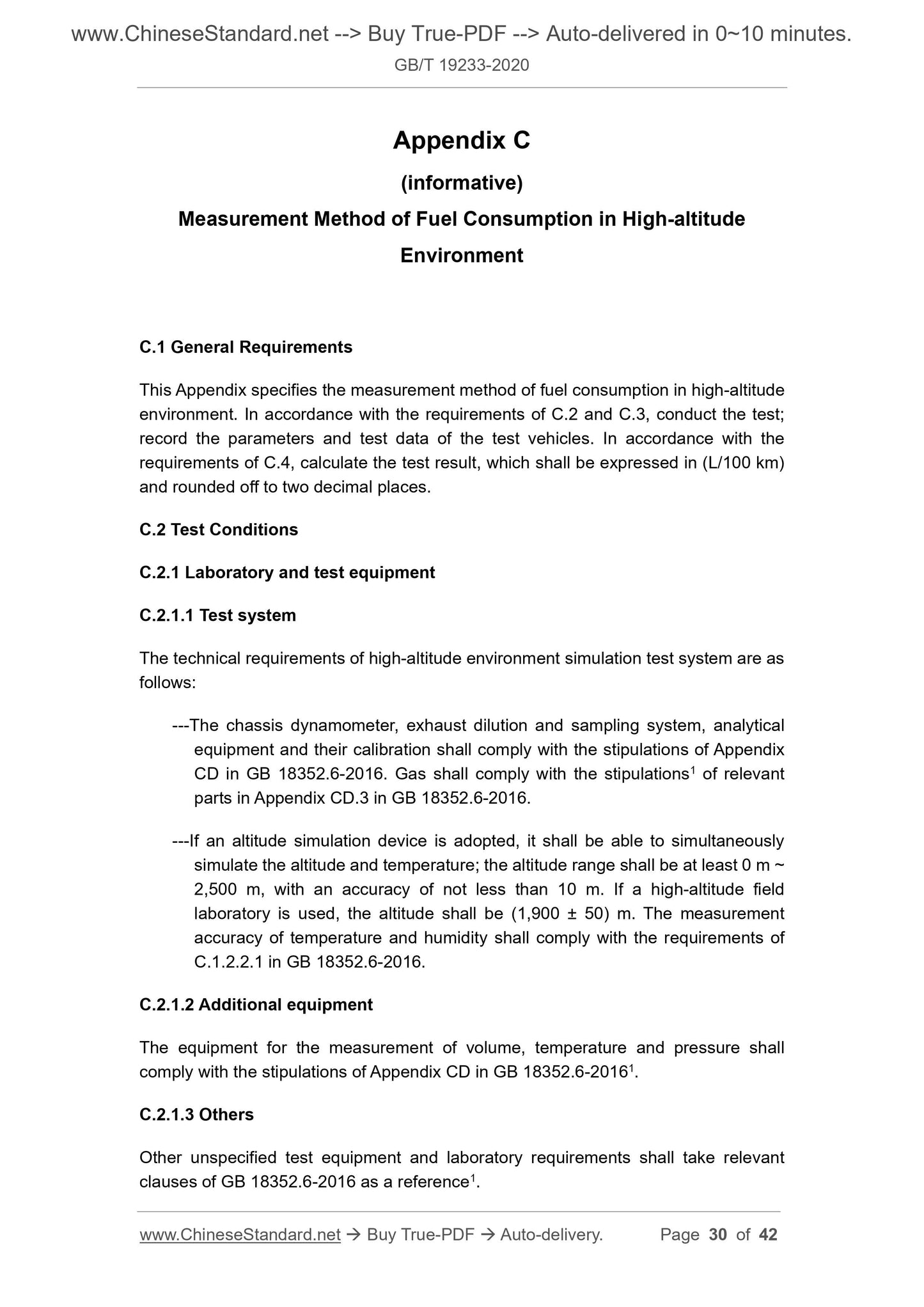1
/
of
12
www.ChineseStandard.us -- Field Test Asia Pte. Ltd.
GB/T 19233-2020 English PDF (GB/T19233-2020)
GB/T 19233-2020 English PDF (GB/T19233-2020)
Regular price
$325.00
Regular price
Sale price
$325.00
Unit price
/
per
Shipping calculated at checkout.
Couldn't load pickup availability
GB/T 19233-2020: Measurement Methods of Fuel Consumption for Light-duty Vehicles
Delivery: 9 seconds. Download (& Email) true-PDF + Invoice.
Get Quotation: Click GB/T 19233-2020 (Self-service in 1-minute)
Historical versions (Master-website): GB/T 19233-2020
Preview True-PDF (Reload/Scroll-down if blank)
GB/T 19233-2020
GB
NATIONAL STANDARD OF THE
PEOPLE’S REPUBLIC OF CHINA
ICS 43.020
T 40
Replacing GB/T 19233-2008
Measurement Methods of Fuel Consumption for Light-
duty Vehicles
ISSUED ON: JUNE 2, 2020
IMPLEMENTED ON: JANUARY 1, 2021
Issued by: State Administration for Market Regulation;
Standardization Administration of the People’s Republic of
China.
Table of Contents
Foreword ... 3
1 Scope ... 6
2 Normative References ... 6
3 Terms and Definitions ... 6
4 General Requirements ... 7
5 Test Conditions ... 7
6 Measurement of CO2, CO and HC Emissions ... 9
7 Calculation of Fuel Consumption ... 10
8 Production Conformity ... 13
9 Approval Extension ... 18
10 Test Lineage ... 19
Appendix A (informative) Measurement Method of Fuel Consumption in Low-
temperature Environment ... 21
Appendix B (informative) Measurement Method of Fuel Consumption when Air-
conditioning is Turned on ... 25
Appendix C (informative) Measurement Method of Fuel Consumption in High-
altitude Environment ... 30
Appendix D (informative) Fuel Consumption Calculation Formulas of Vehicles
of Other Fuel Types ... 33
Appendix E (normative) Type Test Result Report ... 37
Bibliography ... 42
Measurement Methods of Fuel Consumption for Light-
duty Vehicles
1 Scope
This Standard stipulates the test and calculation method that uses the carbon balance
method to calculate fuel consumption, and the inspection and determination method
of production conformity through the determination of automobile carbon dioxide (CO2),
carbon monoxide (CO) and hydrocarbon (HC) emissions.
This Standard is applicable to Type-N1 vehicles, whose maximum design speed is
greater than, or equals to 50 km/h, and Type-M1 and Type-M2 vehicles whose
maximum design total mass does not exceed 3,500 kg, powered by ignition engine or
compression ignition engine; Type-M1 vehicles whose maximum design total mass
exceeds 3,500 kg may take this as a reference.
This Standard is applicable to vehicles that can burn gasoline or diesel, but not
applicable to hybrid electric vehicles. Vehicles of other fuel types may take this as a
reference.
2 Normative References
The following documents are indispensable to the application of this document. In
terms of references with a specified date, only versions with a specified date are
applicable to this document. In terms of references without a specified date, the latest
version (including all the modifications) is applicable to this document.
GB/T 1884 Crude Petroleum and Liquid Petroleum Products - Laboratory
Determination of Density - Hydrometer Method
GB/T 15089-2001 Classification of Power-driven Vehicles and Trailers
GB 18352.6-2016 Limits and Measurement Methods for Emissions from Light-duty
Vehicles (CHINA 6)
GB/T 38146.1-2019 China Automotive Test Cycle - Part 1: Light-duty Vehicles
3 Terms and Definitions
What is defined in GB/T 15089-2001, GB 18352.6-2016, GB/T 38146.1-2019, and the
following terms and definitions are applicable to this document.
The laboratory environment shall comply with the requirements of C.1.2.2 in GB
18352.6-2016.
5.2 Test Vehicles
5.2.1 All components of the test vehicle shall satisfy the requirements for mass
production. If the test vehicle differs from the mass production status, then, detailed
instructions are required.
5.2.2 The vehicle manufacturer or its authorized agent shall submit a vehicle
representing the model being tested to an inspection institution responsible for the type
test. If the vehicle manufacturer or its authorized agent chooses to use the interpolation
lineage, a representative vehicle in the interpolation lineage shall be selected. In
addition, the same test vehicle should be adopted to represent Vehicle H and Vehicle
L through different road load settings.
5.2.3 The test vehicle may be running-in in accordance with the demands of the vehicle
manufacturer or its authorized agent. Ensure that the mechanical condition is good,
and the run-in mileage does not exceed 15,000 km.
5.2.4 Lubricating agents stipulated by the vehicle manufacturer shall be used and
indicated in the test result report.
5.2.5 The other settings1 of the test vehicle shall comply with the requirements of
C.1.2.4.2 ~ C.1.2.4.5 and C.1.2.4.7 in GB 18352.6-2016.
5.3 Test Fuel
5.3.1 The type test shall comply with the lowest reference mark recommended by the
vehicle manufacturer. Reference fuel that meets the requirements of Appendix K in GB
18352.6-2016 shall be used; no additional oxygenate is allowed in the fuel. When using
fuel types not specified in Appendix K of GB 18352.6-2016, commercial vehicle fuels
that comply with relevant national standards shall be used.
5.3.2 When performing the calculation described in 4.5, the value of fuel parameters is
as follows:
a) Density: the density of test fuel measured in accordance with the method of
GB/T 1884;
b) Hydrogen-carbon ratio: a fixed value: 1.85 for gasoline and 1.85 for diesel.
5.4 Test Equipment
The technical characteristics of test equipment shall comply with the stipulations of
1 In the relevant quoted clauses of GB 18352.6-2016, the “environmental protection authority” refers to
the “automotive fuel consumption authority”; “CO2 emission” refers to “fuel consumption” in this Standard.
FCave i---the arithmetic mean value of fuel consumption of the ith speed section,
expressed in (L/100 km);
Di---the theoretical driving distance of the ith speed section, expressed in (km).
h) If the type approval value does not adopt the comprehensive value submitted
and declared by the vehicle manufacturer, the type approval value of fuel
consumption of each speed section shall be calculated in accordance with the
arithmetic mean value of the test result of fuel consumption of corresponding
speed section.
7.6 The format of the type test result report is shown in Appendix E.
8 Production Conformity
8.1 Production Conformity Test and Requirements
8.1.1 General requirements
8.1.1.1 As a general rule, the content and type approval value in the test result report
in Appendix E shall be used as the basis to review the production conformity guarantee
measures of vehicles in terms of fuel consumption.
8.1.1.2 If a certain model has several extended models or interpolation lineage models,
the production conformity test shall be conducted on the basic model described in the
application materials of the first type test. If the production of the basic model of the
first type test has been suspended, the production conformity test shall be performed
on the extended models or interpolation lineage models.
8.1.2 Production conformity test
8.1.2.1 The reference fuel mark number used in the production conformity test shall be
the same as that in the type test.
8.1.2.2 Randomly take 3 vehicles from a batch of products, in accordance with the
stipulations of Chapter 4 ~ Chapter 6, conduct the test.
8.1.2.3 When the vehicle manufacturer’s production standard deviation is satisfying,
the test and determination may be performed in accordance with 8.2. When the vehicle
manufacturer’s production standard deviation is obviously dissatisfying or unavailable,
the test and determination shall be performed in accordance with 8.3.
8.1.2.4 Take the test of 3 sample vehicles as the basis. In accordance with the
determination criteria provided in the corresponding table, determine it. Once it is
determined as qualified or disqualified in accordance with the test statistics, then, this
batch of products shall be qualified or disqualified.
Where,
EC---gradient coefficient, which may be less than 1;
FCx km---fuel consumption of “x” kilometers, expressed in (L/100 km);
FC0 km---fuel consumption of zero kilometers, expressed in (L/100 km).
c) The subsequent vehicles do not need to be running-in, but their fuel
consumption at zero kilometers needs to be multiplied by the gradient
coefficient EC. At this time, the taken value is:
---The first vehicle: fuel consumption of “x” kilometers;
---The subsequent vehicles: fuel consumption of zero kilometers multiplied by
the gradient coefficient.
8.1.3.4 As an alternative to this regulation, the vehicle manufacturer may adopt a fixed
gradient coefficient 0.95. All fuel consumption values measured at zero kilometers shall
be multiplied by this coefficient.
8.2 Production Conformity Inspection when Vehicle Manufacturer’s
Statistical Data is Satisfying
8.2.1 When the minimum number of sample vehicles is 3, the stipulations of the
sampling procedure are as follows: when 40% of a batch of products have production
defects, the probability of passing the test is 0.95 (manufacturer’s risk = 5%); when 65%
of a batch of products have production defects, the probability of being accepted is 0.1
(customer’s risk = 10%).
8.2.2 Quantify the sum of the standard deviation of the type approval value; use
Formula (8) to calculate the test statistics of the sample vehicles:
Where,
s---the measured value is the estimated value of production standard deviation after
natural logarithm;
L---natural logarithm of type approval value of fuel consumption;
xi---natural logarithm of the measured value of the ith vehicle in the sample vehicles;
c) Types of vehicle body, such as:
---Type-M1 and Type-M2: common type, rear-door type, travel type, double-
door type, open type and multi-purpose type;
---Type-N1: flat type, compartment type, tank type.
d) Overall gear ratio4.
e) Engine equipment and accessories.
10 Test Lineage
10.1 General Requirements
The test lineage defined in C.1.2.3.1 in GB 18352.6-2016 is applicable to this
Standard1.
10.2 Determination of Fuel Consumption in Test Lineage
10.2.1 If the vehicle satisfies the requirements of C.1.2.3.1.1 in GB 18352.6-2016, the
same interpolation lineage1 may be constituted. In accordance with the vehicle
manufacturer’s requirements, adopt one of the following two methods to determine fuel
consumption of vehicles in the test lineage.
a) The fuel consumption of vehicle H tested and calculated in accordance with
Chapter 4 ~ Chapter 6, and CE.3.2.1 in GB 18352.6-2016 is applicable to all
the vehicle models in the interpolation lineage1;
b) In accordance with Chapter 4 ~ Chapter 6, test the fuel consumption of vehicle
H and vehicle L; in accordance with the methods in CE.3.2.3.2.1 ~
CE.3.2.3.2.4 in GB 18352.6-2016, calculate the fuel consumption1 of all the
vehicle models in the interpolation lineage. Specifically speaking, if the
difference of fuel consumption between the test vehicle L and vehicle H is
within the specified range, then, the interpolation method can be used. The
lower limit of this specified range is: 0.2 L/100 km; the upper limit is 20% of
the actual fuel consumption of vehicle H, plus 0.2 L/100 km; the minimum is
0.6 L/100 km, and the maximum is 1.2 L/100 km. The interpolation line can
be extrapolated up to 0.12 L/100 km greater than the fuel consumption of
vehicle H, or, 0.12 L/100 km smaller than the fuel consumption of vehicle L;
the extension is merely effective within the above-mentioned absolute limits.
10.2.2 If the vehicle satisfies the requirements of C.1.2.3.1.3 in GB 18352.6-2016, the
same road load matrix lineage1 may be constituted. In accordance with the vehicle
4 Total gear ratio refers to the road speed at an engine speed of 1,000 r/min, expressed in km/h, and
calculated in accordance with the rolling circumference of the tires under the test mass load.
Appendix A
(informative)
Measurement Method of Fuel Consumption in Low-temperature
Environment
A.1 General Requirements
This Appendix specifies the measurement method of fuel consumption in low-
temperature environment. In accordance with the requirements of A.2 and A.3, conduct
the test; record the parameters and test data of the test vehicles. With reference to the
requirements in A.4, calculate the test result, which shall be expressed in (L/100 km)
and rounded off to two decimal places.
A.2 Test Conditions
A.2.1 Laboratory and test equipment
A.2.1.1 Low-temperature environment simulation test system
The chassis dynamometer, exhaust dilution and sampling system, analysis equipment
and their calibration shall comply with the stipulations of Appendix CD in GB 18352.6-
2016. Gas shall comply with the stipulations of relevant parts in Appendix CD.3 in GB
18352.6-2016.
A.2.1.2 Additional equipment
The equipment for the measurement of volume, temperature and pressure shall
comply with the stipulations of Appendix CD in GB 18352.6-20161.
A.2.1.3 Others
Other unspecified test equipment and laboratory requirements shall take relevant
clauses of GB 18352.6-2016 as a reference1.
A.2.2 Environmental conditions
A.2.2.1 The average temperature shall be (-7 ± 3) °C.
A.2.2.2 During the test, the laboratory temperature shall be monitored; the temperature
shall be measured at the air outlet of the cooling fan. The ambient temperature in the
report shall be the arithmetic mean value of the laboratory temperature measured at a
fixed interval of not more than 1 min.
during the entire test process, set the temperature to 22 °C; set the airflow control to
defrost the front window.
A.3 Test Procedures
A.3.1 Test cycle
In accordance with the CLTC-P and CLTC-C cycle (in which, CLTC-P is applicable to
Type-M1 vehicles; CLTC-C is applicable to Type-N1 vehicles, and Type-M2 vehicles
whose maximum design total mass does not exceed 3,500 kg) specified in Appendix
A in GB/T 38146.1-2019, or the WLTC cycle described in Appendix CA in GB 18352.6-
2016, conduct the test.
A.3.2 Pre-treatment
A.3.2.1 In accordance with the requirements of C.1.2.2 in GB 18352.6-2016, set the
ambient temperature.
A.3.2.2 In accordance with the requirements of 6.2, set the chassis dynamometer.
Specifically speaking, the resistance setting of the chassis dynamometer shall be
adjusted to simulate the running condition of the vehicle on the road at -7 °C. The
adj...
Delivery: 9 seconds. Download (& Email) true-PDF + Invoice.
Get Quotation: Click GB/T 19233-2020 (Self-service in 1-minute)
Historical versions (Master-website): GB/T 19233-2020
Preview True-PDF (Reload/Scroll-down if blank)
GB/T 19233-2020
GB
NATIONAL STANDARD OF THE
PEOPLE’S REPUBLIC OF CHINA
ICS 43.020
T 40
Replacing GB/T 19233-2008
Measurement Methods of Fuel Consumption for Light-
duty Vehicles
ISSUED ON: JUNE 2, 2020
IMPLEMENTED ON: JANUARY 1, 2021
Issued by: State Administration for Market Regulation;
Standardization Administration of the People’s Republic of
China.
Table of Contents
Foreword ... 3
1 Scope ... 6
2 Normative References ... 6
3 Terms and Definitions ... 6
4 General Requirements ... 7
5 Test Conditions ... 7
6 Measurement of CO2, CO and HC Emissions ... 9
7 Calculation of Fuel Consumption ... 10
8 Production Conformity ... 13
9 Approval Extension ... 18
10 Test Lineage ... 19
Appendix A (informative) Measurement Method of Fuel Consumption in Low-
temperature Environment ... 21
Appendix B (informative) Measurement Method of Fuel Consumption when Air-
conditioning is Turned on ... 25
Appendix C (informative) Measurement Method of Fuel Consumption in High-
altitude Environment ... 30
Appendix D (informative) Fuel Consumption Calculation Formulas of Vehicles
of Other Fuel Types ... 33
Appendix E (normative) Type Test Result Report ... 37
Bibliography ... 42
Measurement Methods of Fuel Consumption for Light-
duty Vehicles
1 Scope
This Standard stipulates the test and calculation method that uses the carbon balance
method to calculate fuel consumption, and the inspection and determination method
of production conformity through the determination of automobile carbon dioxide (CO2),
carbon monoxide (CO) and hydrocarbon (HC) emissions.
This Standard is applicable to Type-N1 vehicles, whose maximum design speed is
greater than, or equals to 50 km/h, and Type-M1 and Type-M2 vehicles whose
maximum design total mass does not exceed 3,500 kg, powered by ignition engine or
compression ignition engine; Type-M1 vehicles whose maximum design total mass
exceeds 3,500 kg may take this as a reference.
This Standard is applicable to vehicles that can burn gasoline or diesel, but not
applicable to hybrid electric vehicles. Vehicles of other fuel types may take this as a
reference.
2 Normative References
The following documents are indispensable to the application of this document. In
terms of references with a specified date, only versions with a specified date are
applicable to this document. In terms of references without a specified date, the latest
version (including all the modifications) is applicable to this document.
GB/T 1884 Crude Petroleum and Liquid Petroleum Products - Laboratory
Determination of Density - Hydrometer Method
GB/T 15089-2001 Classification of Power-driven Vehicles and Trailers
GB 18352.6-2016 Limits and Measurement Methods for Emissions from Light-duty
Vehicles (CHINA 6)
GB/T 38146.1-2019 China Automotive Test Cycle - Part 1: Light-duty Vehicles
3 Terms and Definitions
What is defined in GB/T 15089-2001, GB 18352.6-2016, GB/T 38146.1-2019, and the
following terms and definitions are applicable to this document.
The laboratory environment shall comply with the requirements of C.1.2.2 in GB
18352.6-2016.
5.2 Test Vehicles
5.2.1 All components of the test vehicle shall satisfy the requirements for mass
production. If the test vehicle differs from the mass production status, then, detailed
instructions are required.
5.2.2 The vehicle manufacturer or its authorized agent shall submit a vehicle
representing the model being tested to an inspection institution responsible for the type
test. If the vehicle manufacturer or its authorized agent chooses to use the interpolation
lineage, a representative vehicle in the interpolation lineage shall be selected. In
addition, the same test vehicle should be adopted to represent Vehicle H and Vehicle
L through different road load settings.
5.2.3 The test vehicle may be running-in in accordance with the demands of the vehicle
manufacturer or its authorized agent. Ensure that the mechanical condition is good,
and the run-in mileage does not exceed 15,000 km.
5.2.4 Lubricating agents stipulated by the vehicle manufacturer shall be used and
indicated in the test result report.
5.2.5 The other settings1 of the test vehicle shall comply with the requirements of
C.1.2.4.2 ~ C.1.2.4.5 and C.1.2.4.7 in GB 18352.6-2016.
5.3 Test Fuel
5.3.1 The type test shall comply with the lowest reference mark recommended by the
vehicle manufacturer. Reference fuel that meets the requirements of Appendix K in GB
18352.6-2016 shall be used; no additional oxygenate is allowed in the fuel. When using
fuel types not specified in Appendix K of GB 18352.6-2016, commercial vehicle fuels
that comply with relevant national standards shall be used.
5.3.2 When performing the calculation described in 4.5, the value of fuel parameters is
as follows:
a) Density: the density of test fuel measured in accordance with the method of
GB/T 1884;
b) Hydrogen-carbon ratio: a fixed value: 1.85 for gasoline and 1.85 for diesel.
5.4 Test Equipment
The technical characteristics of test equipment shall comply with the stipulations of
1 In the relevant quoted clauses of GB 18352.6-2016, the “environmental protection authority” refers to
the “automotive fuel consumption authority”; “CO2 emission” refers to “fuel consumption” in this Standard.
FCave i---the arithmetic mean value of fuel consumption of the ith speed section,
expressed in (L/100 km);
Di---the theoretical driving distance of the ith speed section, expressed in (km).
h) If the type approval value does not adopt the comprehensive value submitted
and declared by the vehicle manufacturer, the type approval value of fuel
consumption of each speed section shall be calculated in accordance with the
arithmetic mean value of the test result of fuel consumption of corresponding
speed section.
7.6 The format of the type test result report is shown in Appendix E.
8 Production Conformity
8.1 Production Conformity Test and Requirements
8.1.1 General requirements
8.1.1.1 As a general rule, the content and type approval value in the test result report
in Appendix E shall be used as the basis to review the production conformity guarantee
measures of vehicles in terms of fuel consumption.
8.1.1.2 If a certain model has several extended models or interpolation lineage models,
the production conformity test shall be conducted on the basic model described in the
application materials of the first type test. If the production of the basic model of the
first type test has been suspended, the production conformity test shall be performed
on the extended models or interpolation lineage models.
8.1.2 Production conformity test
8.1.2.1 The reference fuel mark number used in the production conformity test shall be
the same as that in the type test.
8.1.2.2 Randomly take 3 vehicles from a batch of products, in accordance with the
stipulations of Chapter 4 ~ Chapter 6, conduct the test.
8.1.2.3 When the vehicle manufacturer’s production standard deviation is satisfying,
the test and determination may be performed in accordance with 8.2. When the vehicle
manufacturer’s production standard deviation is obviously dissatisfying or unavailable,
the test and determination shall be performed in accordance with 8.3.
8.1.2.4 Take the test of 3 sample vehicles as the basis. In accordance with the
determination criteria provided in the corresponding table, determine it. Once it is
determined as qualified or disqualified in accordance with the test statistics, then, this
batch of products shall be qualified or disqualified.
Where,
EC---gradient coefficient, which may be less than 1;
FCx km---fuel consumption of “x” kilometers, expressed in (L/100 km);
FC0 km---fuel consumption of zero kilometers, expressed in (L/100 km).
c) The subsequent vehicles do not need to be running-in, but their fuel
consumption at zero kilometers needs to be multiplied by the gradient
coefficient EC. At this time, the taken value is:
---The first vehicle: fuel consumption of “x” kilometers;
---The subsequent vehicles: fuel consumption of zero kilometers multiplied by
the gradient coefficient.
8.1.3.4 As an alternative to this regulation, the vehicle manufacturer may adopt a fixed
gradient coefficient 0.95. All fuel consumption values measured at zero kilometers shall
be multiplied by this coefficient.
8.2 Production Conformity Inspection when Vehicle Manufacturer’s
Statistical Data is Satisfying
8.2.1 When the minimum number of sample vehicles is 3, the stipulations of the
sampling procedure are as follows: when 40% of a batch of products have production
defects, the probability of passing the test is 0.95 (manufacturer’s risk = 5%); when 65%
of a batch of products have production defects, the probability of being accepted is 0.1
(customer’s risk = 10%).
8.2.2 Quantify the sum of the standard deviation of the type approval value; use
Formula (8) to calculate the test statistics of the sample vehicles:
Where,
s---the measured value is the estimated value of production standard deviation after
natural logarithm;
L---natural logarithm of type approval value of fuel consumption;
xi---natural logarithm of the measured value of the ith vehicle in the sample vehicles;
c) Types of vehicle body, such as:
---Type-M1 and Type-M2: common type, rear-door type, travel type, double-
door type, open type and multi-purpose type;
---Type-N1: flat type, compartment type, tank type.
d) Overall gear ratio4.
e) Engine equipment and accessories.
10 Test Lineage
10.1 General Requirements
The test lineage defined in C.1.2.3.1 in GB 18352.6-2016 is applicable to this
Standard1.
10.2 Determination of Fuel Consumption in Test Lineage
10.2.1 If the vehicle satisfies the requirements of C.1.2.3.1.1 in GB 18352.6-2016, the
same interpolation lineage1 may be constituted. In accordance with the vehicle
manufacturer’s requirements, adopt one of the following two methods to determine fuel
consumption of vehicles in the test lineage.
a) The fuel consumption of vehicle H tested and calculated in accordance with
Chapter 4 ~ Chapter 6, and CE.3.2.1 in GB 18352.6-2016 is applicable to all
the vehicle models in the interpolation lineage1;
b) In accordance with Chapter 4 ~ Chapter 6, test the fuel consumption of vehicle
H and vehicle L; in accordance with the methods in CE.3.2.3.2.1 ~
CE.3.2.3.2.4 in GB 18352.6-2016, calculate the fuel consumption1 of all the
vehicle models in the interpolation lineage. Specifically speaking, if the
difference of fuel consumption between the test vehicle L and vehicle H is
within the specified range, then, the interpolation method can be used. The
lower limit of this specified range is: 0.2 L/100 km; the upper limit is 20% of
the actual fuel consumption of vehicle H, plus 0.2 L/100 km; the minimum is
0.6 L/100 km, and the maximum is 1.2 L/100 km. The interpolation line can
be extrapolated up to 0.12 L/100 km greater than the fuel consumption of
vehicle H, or, 0.12 L/100 km smaller than the fuel consumption of vehicle L;
the extension is merely effective within the above-mentioned absolute limits.
10.2.2 If the vehicle satisfies the requirements of C.1.2.3.1.3 in GB 18352.6-2016, the
same road load matrix lineage1 may be constituted. In accordance with the vehicle
4 Total gear ratio refers to the road speed at an engine speed of 1,000 r/min, expressed in km/h, and
calculated in accordance with the rolling circumference of the tires under the test mass load.
Appendix A
(informative)
Measurement Method of Fuel Consumption in Low-temperature
Environment
A.1 General Requirements
This Appendix specifies the measurement method of fuel consumption in low-
temperature environment. In accordance with the requirements of A.2 and A.3, conduct
the test; record the parameters and test data of the test vehicles. With reference to the
requirements in A.4, calculate the test result, which shall be expressed in (L/100 km)
and rounded off to two decimal places.
A.2 Test Conditions
A.2.1 Laboratory and test equipment
A.2.1.1 Low-temperature environment simulation test system
The chassis dynamometer, exhaust dilution and sampling system, analysis equipment
and their calibration shall comply with the stipulations of Appendix CD in GB 18352.6-
2016. Gas shall comply with the stipulations of relevant parts in Appendix CD.3 in GB
18352.6-2016.
A.2.1.2 Additional equipment
The equipment for the measurement of volume, temperature and pressure shall
comply with the stipulations of Appendix CD in GB 18352.6-20161.
A.2.1.3 Others
Other unspecified test equipment and laboratory requirements shall take relevant
clauses of GB 18352.6-2016 as a reference1.
A.2.2 Environmental conditions
A.2.2.1 The average temperature shall be (-7 ± 3) °C.
A.2.2.2 During the test, the laboratory temperature shall be monitored; the temperature
shall be measured at the air outlet of the cooling fan. The ambient temperature in the
report shall be the arithmetic mean value of the laboratory temperature measured at a
fixed interval of not more than 1 min.
during the entire test process, set the temperature to 22 °C; set the airflow control to
defrost the front window.
A.3 Test Procedures
A.3.1 Test cycle
In accordance with the CLTC-P and CLTC-C cycle (in which, CLTC-P is applicable to
Type-M1 vehicles; CLTC-C is applicable to Type-N1 vehicles, and Type-M2 vehicles
whose maximum design total mass does not exceed 3,500 kg) specified in Appendix
A in GB/T 38146.1-2019, or the WLTC cycle described in Appendix CA in GB 18352.6-
2016, conduct the test.
A.3.2 Pre-treatment
A.3.2.1 In accordance with the requirements of C.1.2.2 in GB 18352.6-2016, set the
ambient temperature.
A.3.2.2 In accordance with the requirements of 6.2, set the chassis dynamometer.
Specifically speaking, the resistance setting of the chassis dynamometer shall be
adjusted to simulate the running condition of the vehicle on the road at -7 °C. The
adj...
Share

